Digital Posters
Diffuse Liver & Pancreatic Diseases
ISMRM & SMRT Annual Meeting • 15-20 May 2021

| Concurrent 5 | 13:00 - 14:00 |
1864.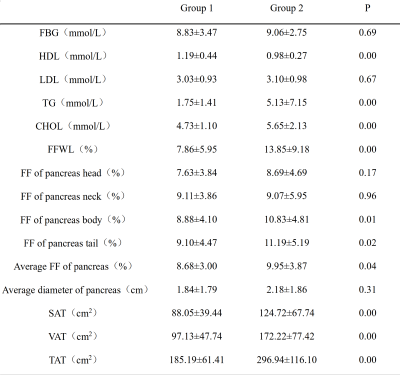 |
The correlation between type 2 diabetes and fat fraction in liver and pancreas: a study using MR Dixon technique
Yu Shun1, Jieqin Lv2, Zhongshuai Zhang3, Ma Mingping1, and Lin Min-gui1
1Radiology department, Fujian Provincial Hospital, fuzhou, China, 2Department of Biomedical Engineering, Southern Medical University, Guangzhou, China, 3Diagnostic Imaging, SIEMENS Healthcare, Shanghai, China
The increased obesity leads to ectopic fat deposits in liver and pancreas. Ectopic fat deposits affect insulin resistance and blood sugar content with Type 2 Diabetes. In order to assess the relationship between obesity and ectopic fat deposits and diabetes, this study used MR Dixon technique for the quantification of liver and pancreas fat fraction (FF) in T2DM patients and healthy controls.
|
|||
1865.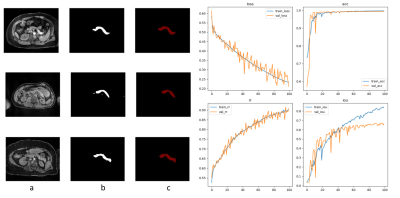 |
Evaluation of Modified Convolutional Neural Network for Automatic Measurement of Pancreas Volume and Pancreatic Fat Deposition
Zhiyong John Yang1, Dech Dokpuang 2, Rinki Murphy 3, Reza Nemati 4, Xavier Yin 5, Kevin Haokun He 5, and Jun Lu1
1School of Biomedical Science, Auckland University of Technology, Auckland, New Zealand, 2Auckland University of Technology, Auckland, New Zealand, 3University of Auckland, Auckland, New Zealand, 4. Canterbury Health Laboratories, Christchurch, New Zealand, 5Saint Kentigern College, Auckland, New Zealand
Pancreatic fat has been reported to be closely related to type 2 diabetes risk, hence is the subject of our investigation in a clinical trial. Artificial pancreatic fat quantification is an experienced operator based and time consuming task. In our recent task, a convolutional neural network were trained based on latest accurate artificial quantification method. Result showed the identification rate were significantly improved through the program.
|
|||
1866.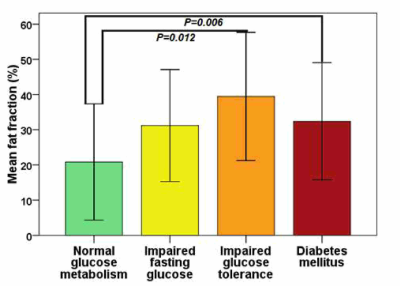 |
Pancreatic fat fraction is a marker of altered glucidic metabolism in thalassemia major
Antonella Meloni1, Mario Nobile2, Laura Pistoia1, Vincenzo Positano1, Emanuele Grassedonio2, Petra Keilberg1, Costanza Bosi3, Luciana Rigoli4, Giulia Guerrini5, Alessandra De Mitrio6, Massimo Midiri2, and Alessia Pepe1
1MRI Unit, Fondazione G. Monasterio CNR-Regione Toscana, Pisa, Italy, 2Policlinico "Paolo Giaccone", Palermo, Italy, 3Ospedale “G. Da Saliceto”, Piacenza, Italy, 4Policlinico "G. Martino", Messina, Italy, 5P.O. Misericordia Grosseto, Grosseto, Italy, 6A.S.L. di Bari, Bari, Italy
Pancreatic fat fraction should be included in the routine MRI examination of thalassemia major patients and employed as an index of increased risk for development of impaired glucose tolerance and overt diabetes mellitus.
|
|||
1867. |
Automated pancreas sub-segmentation by groupwise registration and minimal annotation enables regional assessment of disease
Alexandre Triay Bagur1,2, Ged Ridgway2, Sir Michael Brady2,3, and Daniel Bulte1
1Department of Engineering Science, The University of Oxford, Oxford, United Kingdom, 2Perspectum Ltd, Oxford, United Kingdom, 3Department of Oncology, The University of Oxford, Oxford, United Kingdom
A method to automatically segment the pancreas into its main subcomponents head, body and tail is presented. The method uses groupwise registration to a reference template image that is subsequently annotated by parts. A new subject is registered to the template image, where part labels are propagated, and then transformed back to subject space. We test the method on the UK Biobank imaging sub-study, using a nominally healthy all-male cohort of 50 subjects for template creation and 20 other subjects for validation. We show pancreas T1 quantification by segment when reslicing the segmentation on a separate T1 slice.
|
|||
1868.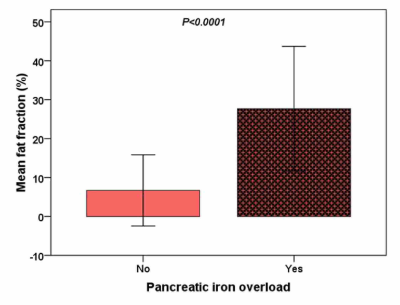 |
Pancreatic fatty infiltration and iron in thalassemia major
Antonella Meloni1, Mario Nobile2, Laura Pistoia1, Vincenzo Positano1, Emanuele Grassedonio2, Petra Keilberg1, Francesco Sorrentino3, Maurizio Caniglia4, Annamaria Carrà5, Domenico Visceglie6, Massimo Midiri2, and Alessia Pepe1
1MRI Unit, Fondazione G. Monasterio CNR-Regione Toscana, Pisa, Italy, 2Policlinico "Paolo Giaccone", Palermo, Italy, 3Ospedale "Sant'Eugenio", Roma, Italy, 4Azienda Ospedaliera "S. Maria Misericordia" di Perugia, Perugia, Italy, 5Ospedale “G. Da Saliceto”, Piacenza, Italy, 6Ospedale “Di Venere”, Bari, Italy
Pancreatic fatty replacement is present in more than three-quarters of patients with thalassemia major and it is associated with ageing. Pancreatic fatty replacement is associated to pancreatic iron overload, with a pancreatic T2* value <18 predicting its presence with a sensitivity of 75.6% and a specificity of 85.4%.
|
|||
1869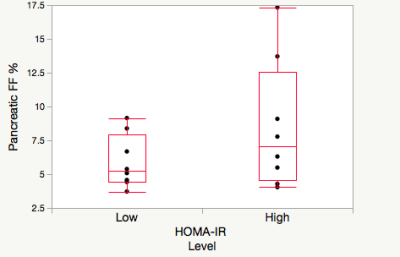 |
Relationship Between Pancreatic Proton Density Fat Fraction and HOMA-IR in Individuals With and Without HIV Infection Video Permission Withheld
Edgar Adrian Castellanos1, Susan Noworolski2, Diana Alba3, Peter Hunt3, and Suneil Koliwad3
1Department of Radiology and Biomedical Imaging, University of California , San Francisco, San Francisco, CA, United States, 2Department of Radiology and Biomedical Imaging, University of California, San Francisco, San Francisco, CA, United States, 3Department of Medicine and Diabetes Center, University of California, San Francisco, San Francisco, CA, United States
Individuals with HIV+ infection have a higher rate of progression to type 2 diabetes mellitus (T2DM), although the mechanisms are not fully understood. Pancreatic proton density fat fraction (PDFF) measures were shown to not differ between individuals with HIV+ (n=16) and controls (n=16). However, when stratified to high versus low measures of insulin resistance (using HOMA-IR), individuals with HIV+ infection (but not controls), who had high HOMA-IR had higher pancreatic PDFF than those with low HOMA-IR, p=0.01. These results suggest pancreatic PDFF may be useful to monitor in HIV+ infection.
|
|||
1870.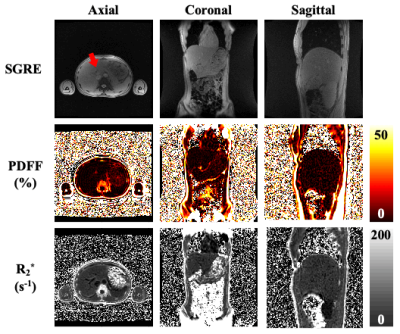 |
Optimization of Flip Angle Modulated Motion Robust 2D Chemical Shift Encoded MRI of the Liver
Ruiyang Zhao1,2, Jitka Starekova1, Scott B Reeder1,2,3,4,5, and Diego Hernando1,2
1Radiology, University of Wisconsin-Madison, Madison, WI, United States, 2Medical Physics, University of Wisconsin-Madison, Madison, WI, United States, 3Biomedical Engineering, University of Wisconsin-Madison, Madison, WI, United States, 4Medicine, University of Wisconsin-Madison, Madison, WI, United States, 5Emergency Medicine, University of Wisconsin-Madison, Madison, WI, United States
Free breathing 2D flip angle modulated (FAM) CSE techniques along three separate orientations (axial/coronal/sagittal) were developed and validated for motion-robust free-breathing liver PDFF and R2* quantification. Six healthy volunteers were recruited and scanned at 3T. Promising results suggest that the proposed optimized 2D FAM CSE techniques along coronal and sagittal directions were able to avoid tissue slice gaps in the liver during free breathing acquisitions. Accurate quantification of PDFF and R2* were also observed with the proposed optimized techniques, as well as improved SNR performance compared to previously proposed low-flip angle 2D CSE.
|
|||
1871.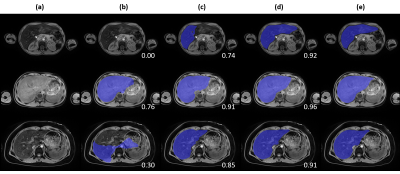 |
A Deep Learning Approach for Robust Segmentation of Livers with High Iron Content from MR Images of Pediatric Patients
Zhoubing Xu1, Guillaume Chabin2, Robert Grimm3, Stephan Kannengiesser3, Li Pan4, Vibhas Deshpande5, Gregor Thoermer3, Sasa Grbic1, and Cara Morin6
1Siemens Healthineers, Princeton, NJ, United States, 2Siemens Healthineers, Paris, France, 3Siemens Healthineers, Erlangen, Germany, 4Siemens Healthineers, Baltimore, MD, United States, 5Siemens Healthineers, Austin, TX, United States, 6St. Jude Children's Research Hospital, Memphis, TN, United States
Automated MRI liver segmentation enables the inline evaluation of parametric maps for iron quantification with improved accuracy, efficiency, and repeatability compared to manual efforts. Existing methods optimized for adults and normal livers do not perform well on challenging cases in children and patients with iron overload. We developed a deep learning-based solution trained on 861 T1-weighted MRI that provided significantly improved liver segmentation compared to a commercially available solution and demonstrated its robustness on a challenging cohort of pediatric patients including cases with high iron content.
|
|||
 |
1872.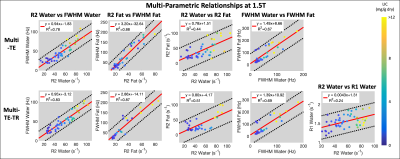 |
Multi-Parametric Relationships in Subjects with Liver Iron Overload Obtained using STEAM-MRS at 1.5T and 3T
Gregory Simchick1,2, Ruiyang Zhao1,2, Gavin Hamilton3, Scott Reeder1,2,4,5,6, and Diego Hernando1,2,4
1Radiology, University of Wisconsin-Madison, Madison, WI, United States, 2Medical Physics, University of Wisconsin-Madison, Madison, WI, United States, 3Radiology, University of California-San Diego, San Diego, CA, United States, 4Biomedical Engineering, University of Wisconsin-Madison, Madison, WI, United States, 5Medicine, University of Wisconsin-Madison, Madison, WI, United States, 6Emergency Medicine, University of Wisconsin-Madison, Madison, WI, United States
The relationships between several promising MR biomarkers of diffuse liver disease were evaluated at both 1.5T and 3T in subjects with liver iron overload using stimulated echo acquisition mode (STEAM) MRS. Multi-TE and multi-TE-TR sequences were acquired in order to obtain estimates of R1, R2, FWHM, and PDFF. Linear regression analysis was performed to evaluate the relationships between these various parameters and their relationships across field strengths. Several biomarkers demonstrated moderate to high correlations with each other, and the multi-TE-TR sequence (lower spectral resolution and higher number of spectra than the multi-TE sequence) tended to produce better correlations.
|
||
1873. |
The Effect of Hepatic Fat on T2 of water signal in single voxel multi-echo MRS and fat-suppressed radial TSE T2 mapping.
Diana Bencikova1,2, Marcus Raudner1, Sarah Poetter-Lang1, Nina Bastati1, Ahmed Ba-Ssalamah1, Siegfried Trattnig1,2, and Martin Krššák2,3
1Department of Radiology, Medical University Vienna, Vienna, Austria, 2Christian Doppler Laboratory for Clinical Molecular Imaging, MOLIMA, Vienna, Austria, 3Division of Endocrinology and Metabolism, Department of Medicine III, Medical University of Vienna, Vienna, Austria
MRI-based T2 mapping was suggested for the grading of hepatic parenchyma inflammation. Studies using multi-echo MRS suggest the effect of hepatic fat accumulation on T2 values of the water signal. Here, we analyzed the effect of hepatic fat fraction on water T2s in phantoms and patients in vivo with MRS and T2 mapping based on fast radial turbo-spin-echo acquisition with fat saturation. While there was an effect in phantoms of low FF, in the population of patients with FF up to 15%, no significant influence could be observed.
|
|||
1874.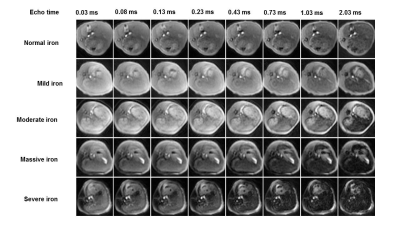 |
R2* mapping in liver iron quantification using multi-echo ultra-short echo time MRI: a rabbit model study
Hongru Jia1, Chang Liu1, Weiqiang Dou2, Jing Ye1, and Xianfu Luo1
1Northern Jiangsu People’s Hospital, Yangzhou, China., Yangzhou, China, 2GE Healthcare,MR Research China, Beijing, China., Beijing, China
In this study, we aimed to investigate the feasibility of quantitative R2* mapping measured using multi-echo ultra-short echo time (multi-TE UTE) MRI for evaluating liver iron content coexisting with liver fat. Iron accumulation and fat deposition with different levels was built in rabbit liver in vivo. We found that the obtained R2* mapping measured with multi-TE UTE with fat suppression could accurate measure liver iron content at different levels without an influence from fat. With this finding, multi-TE UTE imaging can be considered a potential technique for noninvasive hepatic iron measurement.
|
|||
1875.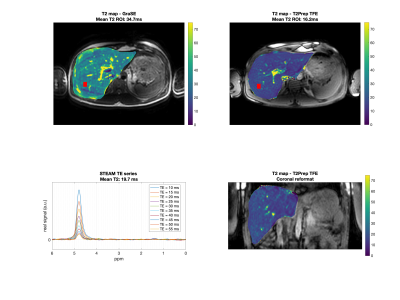 |
Isotropic resolution volumetric liver T2 weighted imaging and T2 mapping using a navigator-gated radial stack-of-stars T2 prepared acquisition
Mark Zamskiy1, Dominik Weidlich1, Kilian Weiss2, Marcus Makowski1, Rickmer Braren1, and Dimitrios Karampinos1
1Department of Diagnostic and Interventional Radiology, School of Medicine, Technical University of Munich, Munich, Germany, 2Philips Healthcare, Hamburg, Germany
Volumetric liver T2-weighted imaging and T2 mapping is of a high clinical significance but still remains very challenging due to motion in this region. The present work introduces a novel T2-prepared radial stack-of-stars (SoS) gradient echo sequence, which can be combined with a DIXON readout for achieving isotropic resolution fat-suppressed T2-weighted images. Moreover, the combination of the T2-prepared SoS acquisition with different T2-preparations enables T2 mapping in navigator-gated scans.
|
|||
1876.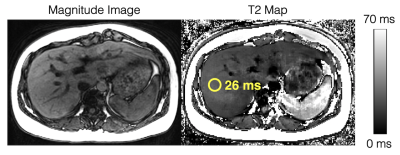 |
T2 Quantification in Liver Iron Overload Using RF Phase Modulated Gradient Echo MRI
Ruvini Navaratna1,2, Daiki Tamada2, Gregory Simchick2, Diego Hernando1,2, and Scott B Reeder1,2,3,4,5
1Medical Physics, University of Wisconsin - Madison, Madison, WI, United States, 2Radiology, University of Wisconsin - Madison, Madison, WI, United States, 3Biomedical Engineering, University of Wisconsin - Madison, Madison, WI, United States, 4Medicine, University of Wisconsin - Madison, Madison, WI, United States, 5Emergency Medicine, University of Wisconsin - Madison, Madison, WI, United States
MR-based relaxation parameters such as T2 are sensitive to iron content in the liver. Unfortunately, current T2 mapping techniques often suffer from long acquisition times. A recently introduced phase-based T2 mapping technique shows promise for rapid liver T2 quantification within a single breath-hold. However, its ability to quantify short T2 in liver iron overload is unknown. In this work, we present a modified 3D phase-based T2 mapping method for quantifying short T2 values encountered in liver iron overload. Our results demonstrate preliminary feasibility of phase-based RF modulated GRE to map short T2 values rapidly and accurately.
|
|||
1877.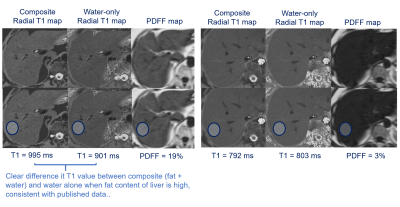 |
Performance of Radial Dual-Echo Inversion Recovery SPGR T1 mapping in comparison to SMART1 and MOLLI for the Evaluation of Liver Parenchyma.
Manoj Mathew1, Zhitao Li2, Ali B Syed3, Shreyas S Vasanawala1, and Ryan L Brunsing1
1Department of Radiology, Stanford University, Palo Alto, CA, United States, 2Department of Radiology and Electrical Engineering, Stanford University, Palo Alto, CA, United States, 3Stanford University, Palo Alto, CA, United States
Radial Dual-Echo Inversion Recovery SPGR T1 mapping is a technique that yields water and fat separated parametric maps for the evaluation of T1 values in the liver parenchyma. This novel method can serve as an alternative to SMART1 and MOLLI mapping techniques. From a cohort of 56 patients, we show the rIR-T1 outperforms MOLLI in the differentiation of patients with cirrhosis. We also show that the technique may be advantageous in the evaluation of patients with hepatic steatosis because of the ability to create composite and water-only images that yield T1 values that can better correlate to liver fibrosis.
|
|||
1878.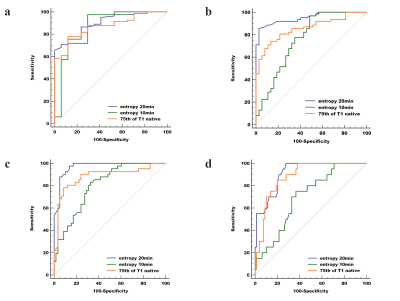 |
Feasibility of T1 Mapping with Histogram Analysis for the Diagnosis and Staging of Liver Fibrosis: Preclinical Results
Qing Wang1, Ye Sheng2, HaiFeng Liu2, Zuhui Zhu2, wei Xing2, and Jilei Zhang3
1Radiology, Third Affiliated Hospital of Soochow University & First People's Hospital of Changzhou, changzhou, China, 2Third Affiliated Hospital of Soochow University & First People's Hospital of Changzhou, changzhou, China, 3Healthcare,Shanghai,China, shanghai, China
We induced LF New Zealand white rabbits model by carbon tetrachloride to compare the diagnostic accuracy of parameters derived from the histogram analysis of precontrast, 10-min hepatobiliary phase (HBP) and 20-min HBP MOLLI T1 maps for staging liver fibrosis (LF). The mean, median, skewness, kurtosis, entropy, inhomogeneity and 10th/25th/75th/90th percentiles of T1native, T110min and T120min were compared. The 75th of T1native, entropy10min, and entropy20min were the three most reliable imaging markers in reflecting the stage of LF. The entropy derived from 20-min HBP T1 mapping is the best parameter for predicting the LF stage.
|
|||
1879.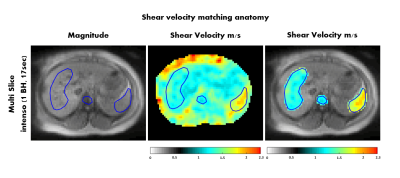 |
Intenso MRE: 3D volumetric GRE-based MR Elastography of the liver in a single breath-hold
Omar Isam Darwish1,2,3, Sami Jeljeli1, Daniel Staeb4, Peter Speier5, Ralph Sinkus1,2, and Radhouene Neji1,3
1King's College London, London, United Kingdom, 2INSERM U1148, LVTS, University Paris Diderot, Paris, France, 3MR Research Collaborations, Siemens Healthcare Limited, Frimley, United Kingdom, 4MR Research Collaborations, Siemens Healthcare Limited, Melbourne, Australia, 5MR Application Predevelopment, Siemens Healthcare GmbH, Erlangen, Germany
The increasing use of MR elastography (MRE) for the quantification of liver fibrosis and inflammation demands a rapid and accurate 3D MRE sequence. 3D MRE usually requires multiple breath-holds, which prolongs acquisition times and introduces misalignment between the different acquisitions. We propose Intenso, a novel GRE-MRE sequence that enables 3D motion-encoding for volumetric MRE of the liver in a single breath-hold. The sequence combines simultaneous multi-slice excitation (SMS), Hadamard motion encoding and a multi-shot GRE-MRE sequence resulting in a total acquisition time of 17 seconds. In-vivo results are shown in three healthy volunteers and compared to a well-established GRE-MRE sequence.
|
|||
1880.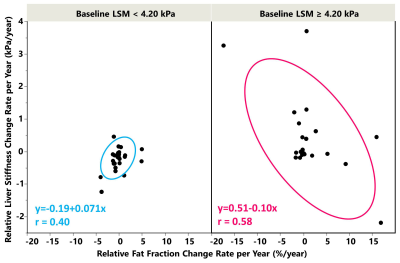 |
Longitudinal MRI and MR Elastography (MRE) Assessment in Patients with Diagnosed Nonalcoholic Fatty Liver Disease (NAFLD)
Zheng Zhu1, Alina M. Allen2, Terry Therneau3, Xin Lu1, Kevin J. Glaser1, Jiahui Li1, Jingbiao Chen1,4, Jie Chen1,5, Safa Hoodeshenas1, Sudhakar K. Venkatesh1, Armando Manduca1,6, Richard L. Ehman1, and Meng Yin1
1Department of Radiology, Mayo Clinic, Rochester, MN, United States, 2Devision of Gastroenterology and Hepatology, Mayo Clinic, Rochester, MN, United States, 3Devision of Biomedical Statistics and Informatics, Mayo Clinic, Rochester, MN, United States, 4Department of Radiology, the Third Affiliated Hospital of Sun Yat-Sen University, Guangdong, China, 5Department of Radiology, West China Hospital, Chengdu, Sichuan, China, 6Devision of Physiology and Biomedical Engineering, Mayo Clinic, Rochester, MN, United States To identify individuals at high risk for rapid fibrosis progression, we retrospectively investigated longitudinal changes in liver stiffness measurements (LSM) and proton density fat fraction (PDFF) in 36 NAFLD patients. At the early fibrosis stages, the rate of change of LSM is slow and positively correlated with the rate of change in PDFF. At later fibrosis stages, the rate of change in LSM is higher and is negatively correlated with ΔPDFF. Compared with other risk factors, the baseline value of LSM and the rate of change in PDFF was most strongly correlated with subsequent change in LSM. |
|||
1881.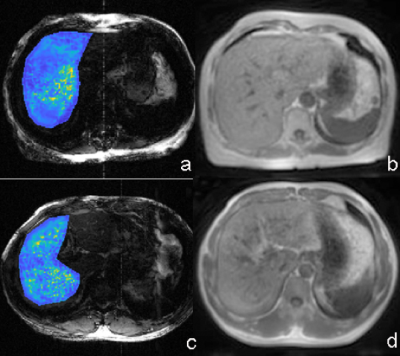 |
A Preliminary Assessment of Hepatic Fibrosis with Ultrashort Echo Time (UTE): A comparative study with Magnetic Resonance Elastography (MRE)
Jie Yuan1, Fan Mo2, Yongming Dai2, Suhao Qiu3, Yuan Feng3, Songhua Zhan1, Yanwen Huang1, and Hui Wang1
1Department of Radiology, Shuguang Hospital Affiliated to Shanghai University of Traditional Chinese Medicine, 201203, Shanghai, China, 2MR Collaboration, United Imaging Healthcare, Shanghai, China, 3Institute for Medical Imaging Technology, School of Biomedical Engineering, Shanghai Jiao Tong University, 200240, Shanghai, China
We investigated the potential of Ultrashort Echo Time (UTE) to accurately assess hepatic fibrosis in patients with chronic liver disease. Our study demonstrated that UTE has the potential to assess the hepatic fibrosis.
|
|||
1882.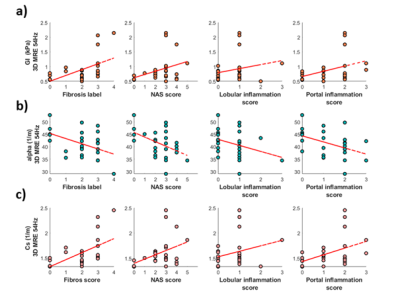 |
Non-Alcoholic Fatty Liver Disease: Association Between the Biomechanics and Inflammation Severity in Early-Stage Diffuse Liver Disease
Christian Simonsson1,2, Markus Karlsson1, Patrik Nasr3, Ralph Sinkus4, Simone Ignatova5, Nils Dahlström1, Mattias Ekstedt2,3, Stergios Kechagias3, and Peter Lundberg1,2
1Department of Radiation Physics, Radiology, Linköping University, Linköping, Sweden, 2Center for Medical Image Science and Visualization (CMIV), Linköping University, Linköping, Sweden, 3Department of Medical and Health Sciences, Linköping University, Linköping, Sweden, 4Imaging Sciences & Biomedical Engineering, Kings College London,, London, United Kingdom, 5Linköping University, Linköping, Sweden
With the high prevalence of non-alcoholic fatty liver disease (NAFLD), it is important to have precise and non-invasive clinical methods to detect early stages of non-alcoholic steatohepatitis (NASH) and fibrosis progression. It has recently been shown that 3D Magnetic resonance elastography (3D-MRE) could be used to measure inflammation in the liver. To this cause, we investigated the association between liver 3D-MRE biomechanical properties and histopathological features in a liver study cohort of 25 patients including individuals with NASH. We here show that 3D-MRE biomechanical biomarkers show a correlation with higher degrees of hepatic inflammation in this cohort.
|
|||
1883.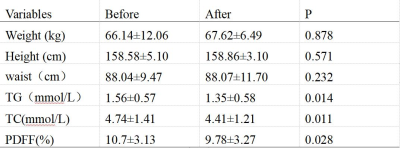 |
Role of mDixon quant imaging in evaluation of treatment outcome with vitamin K2 in non-alcoholic fatty liver disease
Zhiying Xue1, Xiuzheng Yue2, Yishi Wang2, and Tong Zhang1
1Radiology, No.4 Hospital of Harbin Medical University, Harbin, China, 2Philips Healthcare, Beijing, China
Synopsis: Liver fat content in patients with non-alcoholic fatty liver disease (NAFLD) is closely related to the progression of the disease. The objective of this study was to assess the effect of Vitamin K2 (VK2) supplementation on NAFLD using mDixon quant technique. Preliminary results showed supplementation of VK2 could can improve the condition of liver fat deposition of VK2 and related biomarkers to some extent.
|
The International Society for Magnetic Resonance in Medicine is accredited by the Accreditation Council for Continuing Medical Education to provide continuing medical education for physicians.